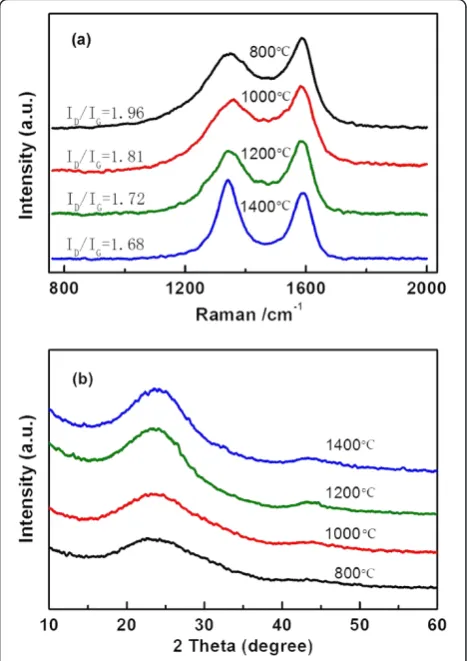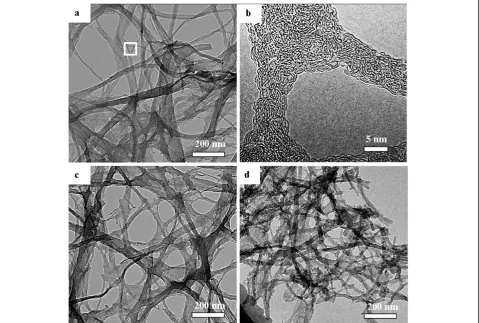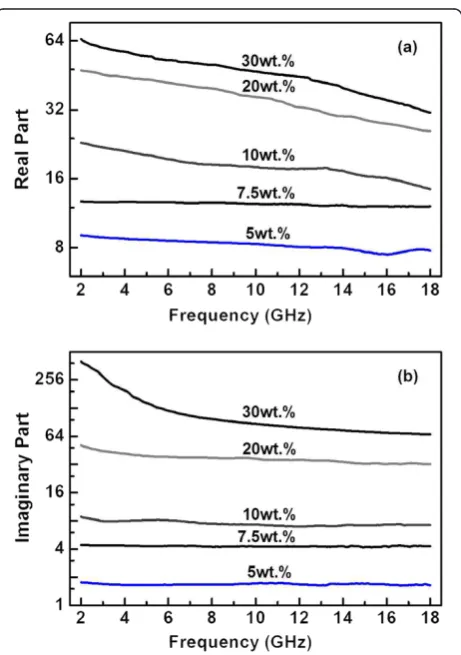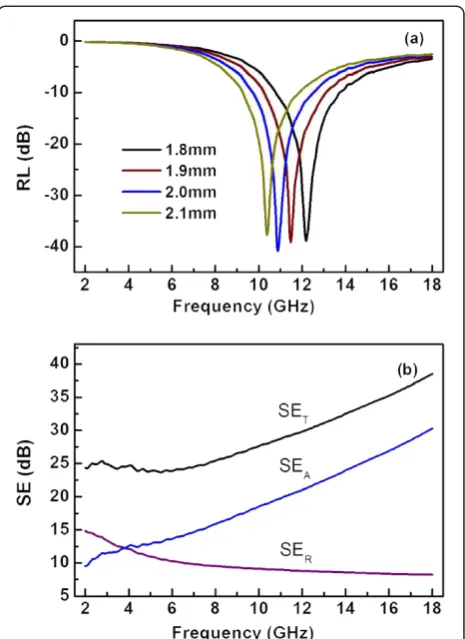N A N O E X P R E S S
Open Access
Microstructure and dielectric properties of
biocarbon nanofiber composites
Bo Dai
1*, Yong Ren
1, Gaihua Wang
1, Yongjun Ma
2, Pei Zhu
1and Shirong Li
1Abstract
A kind of web-like carbon with interconnected nanoribbons was fabricated using bacterial cellulose pyrolyzed at various temperatures, and the microwave dielectric properties were investigated. Bacterial cellulose was converted into carbonized bacterial cellulose (CBC) with a novel three-dimensional web built of entangled and interconnected cellulose ribbons when the carbonization temperature was below 1,200°C; the web-like structure was destroyed at a temperature of 1,400°C. Composites of CBC impregnated with paraffin wax exhibited high complex permittivity over a frequency range of 2 to 18 GHz, depending on the carbonization temperature. Both real and imaginary parts were the highest for CBC pyrolyzed at 1,200°C. The complex permittivity also strongly depended on CBC loadings. For 7.5 wt.% loading, the real and imaginary permittivities were about 12 and 4.3, respectively, and the minimum reflection loss was−39 dB at 10.9 GHz. For 30 wt.% loading, the real and imaginary permittivities were about 45 and 80, respectively, and the shielding efficiency was more than 24 dB in the measured frequency range and could be up to 39 dB at 18 GHz. The electromagnetic properties were assumed to correlate with both the dielectric relaxation and the novel web-like structure.
Keywords:Carbon fibers, Heat treatment, Electrical properties, Transmission electron microscopy (TEM)
Background
The rapid proliferation of advanced electronic devices for many commercial and military applications, such as data transmission, telecommunications, wireless network systems, and satellite broadcasting as well as radar and diagnostic and detection systems, has led to numerous electromagnetic compatibility and electromagnetic inter-ference (EMI) problems. The interaction of electromag-netic waves originating from different sources can lead to a decrease in quality and a misinterpretation of transferred data, and it has thus become vital to avoid such interference and electromagnetic wave pollution through the use of ap-propriate absorbing and shielding materials. Carbonaceous materials - such as graphite and/or carbon black - are often used as dielectric electromagnetic absorbers, generating di-electric loss by improving the di-electrical conductivity of the mixture. In particular, nanostructured materials and carbon fiber composites have been the subjects of growing interest
as microwave radiation absorbing and shielding materials in the high-frequency range due to their fascinating proper-ties [1-5]. It is reported that carbon nanofiber-polymer composites presented EMI shielding effectiveness (SE) of approximately 19 dB with 15 wt.% carbon nanofiber loading [3]. Graphite-coated FeNi nanoparticles exhibited reflection loss (RL) of approximately −23 dB with the thickness 2.5 mm and the absorption peak at 14 GHz [5]. Carbon nanocoils coated with Fe3O4 exhibited remarkably im-proved microwave absorption (RL approximately −20 dB) compared to the pristine carbon nanocoils (RL approxi-mately−2 dB) [6]. Another allotrope of carbon, viz., single-layered two-dimensional graphene, graphene oxide, or reduced graphene oxide, has attracted a great deal of atten-tion for its applicaatten-tion in many diverse areas due to its unique electrical, mechanical, and thermal properties in addition to its light weight, high surface area, and layered morphology. The graphene/epoxy composites exhibited SE of approximately 21 dB in theX-band for a 15 wt.% loading [7]. The reduced graphene oxide exhibits−7 dB RL while graphite only exhibits approximately −1 dB in the fre-quency range of 2 approximately 18 GHz [8]. Further to the considerable interest in adding small concentrations of
* Correspondence:bodai31@vip.sina.com 1
State Key Laboratory Cultivation Base for Nonmetal Composites and Functional Materials, School of Materials Science and Engineering, Southwest University of Science and Technology, Mianyang 621010, People’s Republic of China
Full list of author information is available at the end of the article
nanocarbons into the matrix, what unquestionably matters is the ability to disperse them [9]. The cost and limited supply also hinders the application of nanocarbons as fillers for EMI shielding and microwave absorption. Re-cently, researchers have tried low-cost natural materials (rice husks) as carbonaceous sources to fabricate carbon-matrix composites with self-assembly interconnected car-bon nanoribcar-bon networks [10]. These composites have higher electric conductivities and EMI shielding effective-ness values than those without. In this paper, the example of microwave composites is reported using bacterial cellu-lose as the carbonaceous source, which had self-assembled interconnected nanoribbon networks. These composites exhibited high permittivity in the frequency range of 2 to 18 GHz and thus could be excellent high-loss materials, for example, as an EMI material or high-performance microwave absorbing material. The interesting electromag-netic characteristics are due to the novel three-dimensional web-like networks which establish additional electrical conduction pathways throughout the whole system.
Methods
Sample preparation
Carbonized bacterial cellulose (CBC) was obtained by heat-treated bacterial cellulose (BC), which was pyro-lyzed for 4 h under a nitrogen atmosphere at 800°C, 1,000°C, 1,200°C, or 1,400°C. CBC was cleaned using di-luted hydrochloric acid with volume fraction of 10% and then soaked in concentrated nitric acid at room temperature for 4 h. Afterwards, the black solution was diluted with distilled water and rinsed for several times until the pH value reaches 7. The resulting CBC were separated from the solution by filtration and dried using a vacuum at 60°C for further use. Dried CBC fibers were mechanically milled into powder for the measurement of electromagnetic parameters. The CBC/paraffin wax sam-ples were prepared by uniformly mixing the powders in a paraffin wax matrix. A series of CBC/paraffin wax composites were prepared with CBC loading of up to 30 wt.%. The absorbers were dispersed in ethanol with par-affin wax by stirring and sonication at 90°C for 1 h. The mixtures were then pressed into cylindrical dies with 7.0 mm outer diameter, 3.0 mm inner diameter, and about 2.0 mm height.
Characterization
The morphology of CBC was observed by transmission electron microscopy (TEM, Tecnai F20, FEI, Hillsboro, OR, USA) and scanning electron microscopy (SEM, FEI NOVA600i). The sheet resistance (Rs) of the composites was measured by the four-probe method using a Keithley 2400 multimeter (Cleveland, OH, USA), and the direct current (DC) conductivityσwas obtained using the mea-suredRsand the sheet thicknesstaccording toσ= 1/(Rst).
Complex permittivity and permeability measurements were performed on an Agilent E8363B vector network analyzer in the 2 to 18 GHz frequency range. Three sam-ples were tested for each electromagnetic parameter meas-urement, and the reported results are the averages.
Results and discussion
Phase and microstructure of CBC
[image:2.595.305.539.376.707.2]Raman scattering is a well-accepted characterization method for evaluating the degree of structural order of carbonaceous materials, using the ratio of the integrated intensity of the D band (ID) to that of the G band (IG) [11]. The typical Raman spectra (in a shift regime) of the CBC samples treated at various temperatures are shown in Figure 1a. It displays a prominent G-peak at approxi-mately 1,585 cm−1along with a D-peak at approximately 1,340 cm−1corresponding to the first order scattering of the E2g mode and A1g mode, respectively. There are changes in the ratio of the area for the peaks assigned to the D and G bands, i.e., from 1.96 at 800°C to 1.68 at 1,400°C. The decrease in the ratio of the D/G bands may be explained in terms of an increase in the crystallite do-mains or a reduction in the quantity of amorphous
carbon. Figure 1b shows the X-ray diffraction patterns of samples. It presents diffraction patterns typical of a pre-dominantly amorphous carbon. The increased temperature led to an increase in their crystallinity, which corresponds to the result of Raman measurements.
BC fiber is an extracellular product excreted in the form of pellicles. It is structured in a web-like network by self-assembly of continuous nanofibers about 10 nm thick and 50 nm wide [12]. Each nanofiber is a bundle of cellulose microfibrils, each of which is about 4 nm thick and 4 nm wide. The web-like network leads BC to be homogenously dispersed in the matrices [13], and its composites have significant mechanical strength and ex-tremely low thermal-expansion coefficients [14,15]. After carbonization under a nitrogen atmosphere, BC was converted into a kind of carbon nanoribbon and the cor-responding TEM images are presented in Figure 2. As shown in Figure 2a, the carbonization at temperature of 800°C did not break the pristine structure, and the web-like networks were very well preserved. The carbonized bacterial cellulose networks can be described as a three-dimensional web built of entangled and interconnected cel-lulose ribbons. The width and thickness of the nanoribbons are in the order of tens of nanometers and a few
nanometers, respectively. A higher magnification shows that each ribbon assembly is composed of a number of ex-tended chains of bacterial fibrils (Figure 2b). These fibrils are seen to be in close contact with one another and to twist as a whole. The structure of BC carbonization at 1,200°C is al-most the same as that of carbonization at 800°C, which formed branched nanoribbon networks. However, after carbonization at 1,400°C, branches of the nanoribbon seemed to be broken and the three-dimensional structure degraded to two dimensions. The width of the nanoribbon was narrower than those shown in Figure 2a,c.
Microwave electromagnetic properties of CBC
[image:3.595.59.539.390.713.2]The relative complex permittivity (εr=ε′−jε″) was mea-sured in the frequency range of 2 to 18 GHz. The real (ε′) and imaginary (ε″) parts of permittivity for the com-posites with 20 wt.% CBC loadings pyrolyzed at different temperatures are presented as a function of the fre-quency in Figure 3a,b. Both the real and the imaginary permittivities presented high values. The complex per-mittivity spectra reveal the behaviors of electrical con-duction and dielectric relaxation of the composites. Upon increasing the temperature, the permittivity plots for the specimen displayed a firstly increasing and then
diminishing response. At 1,200°C, the values of both ε′ andε″were the highest. The two mechanisms responsible for the dielectric properties were analyzed. First, there are many mobile charge carriers (electrons or holes) with great mobility in CBC that interact with electromagnetic fields by oscillating when irradiated, just like those in car-bon nanotubes (CNTs). Second, it is proposed that the web-like networks in CBC also established bridges for mo-bile charge carriers along which they can move freely. These additional channels interact with the electromag-netic field over a short range, resulting in high permittiv-ity. With an increase in the pyrolysis temperature, the degree of graphite order increased as discussed above; and thus, there were more mobile charge carriers. How-ever, the web-like networks of carbon nanofiber was somehow destroyed when the pyrolysis temperature in-creased beyond 1,200°C (as shown in Figure 2d). There-fore, it is understandable that the CBC pyrolyzed at 1,200°C exhibited the highest permittivity. In addition, it is noteworthy that the magnitudes of the loss tangent (tan δe=ε″/ε′) approached 1, even exceeded 1, espe-cially for that sample pyrolyzed at 1,200°C. The loss tan-gent is directly related to the attenuation factor α that determines the attenuating property of the material: the
higher the loss tangent, the larger the attenuation factor [16]. Therefore, the high loss tangent for the CBC com-posites signifies that they have good attenuating properties.
Figure 4 shows the dielectric permittivities of the CBC paraffin wax composites with 5 to 30 wt.% CBC pyrolyzed at 1,200°C. It is evident that both the real and imaginary permittivities increased rapidly with CBC concentration. The complex permittivity spectra reveal the behavior of electrical conduction and dielectric relaxation of the com-posites. The rapid increase in the permittivities with con-centration is attributed to the onset of percolation, similar to that of the CNTs [17,18]. Figure 5 is a plot of DC con-ductivity of the CBC/paraffin wax composites versus the amount of the CBC loading pyrolyzed at 1200°C. One can see a sharp increase of conductivity when CBC loading was increased from 1 to 7.5 wt.%. The conductivity of the CBC was of 2 × 10−9S/cm for 1 wt.% and 0.02 S/cm for 7.5 wt.% and reached a relatively high value of 0.5 S/cm for 15 wt.%. This implies that such a composite has a per-colation threshold of about 7.5 wt.%.
[image:4.595.307.538.378.706.2]For microwave absorption, the elelctromagnetic para-meters should be appropriate, and the optimal filler
Figure 3Real (a) and imaginary (b) parts of permittivity for the composites with 20 wt.% CBC loadings.
[image:4.595.57.294.413.706.2]concentration is always around the percolation threshold. Theoretical RL values in the sample with 7.5 wt.% CBC loading were calculated according to the transmission line theory [19].
RL¼20 lgjðZin−1Þ=ðZinþ1Þj ð1Þ
Zin¼
ffiffiffiffiffiffiffiffiffiffiffi
μr=εr
q
tanhjð2πft=cÞpffiffiffiffiffiffiffiffiμrεr ð2Þ
where Zin is the normalized impedance at the absorber surface. Figure 6a shows the frequency dependences of the RL at various sample thickness (t= 1.8, 1.9, 2.0, and 2.1
mm). An optimal RL of −40.9 dB was observed at 10.9
GHz with the−20 dB bandwidth over the frequency range of 10.4 to 11.4 GHz fort= 2.0 mm. The minimum RL ob-viously shifts to lower frequency range with increased thickness, which can be understood according to the geo-metrical effect matching condition in which the thickness of the layer is a quarter wavelength thickness of the mater-ial. It is interesting that microwave absorption properties do not change dramatically for the thicknesses of 1.8 to 2.1mm.
For EMI shielding, the total shielding effectiveness SET
is always expressed by SET= 10 lg(Pin/Pout) = SEA+ SER+ SEI, where Pin and Pout are the power incident on and transmitted through a shielding material, respectively. The SEA and SER are the absorption and reflection shielding
efficiencies, respectively, and can be described as SEA=
8.686 αtand SER= 20 lg |1 +n|2/4|n| [20]. For the
com-posite with 30 wt.% CBC pyrolyzed at 1,200°C, using the measured electromagnetic parameters, we calculated the SEA(with the thicknesstassumed to be 2.0 mm) and the
SER, which together with SEA+ SER are shown in
Figure 6b. It can be seen that the SETincreased from 24
dB in the low frequencies to 39 dB at 18 GHz. The contri-bution to the SET was mainly from the reflection in the
low frequency range and from the absorption in the high range. The EMI shielding efficiency is attributed to the formation of conducting interconnected nanofiber net-works in an insulating paraffin wax matrix that will inter-act with the incident radiation and lead to the high shielding effectiveness.
Conclusions
The pyrolysis of bacterial cellulose led to the formation of a unique interconnected web-like network of carbon nanoribbons, and this was used to fabricate carbon-matrix composites. These composites had remarkable imaginary permittivities and huge loss tangents and thus good attenuating properties. The web-like networks were very helpful for increasing the dielectric loss. The electromagnetic properties could be optimized by ma-nipulating the bacterial nanoribbons by doping or sur-face modification; and thus, the RL and SET could be
[image:5.595.306.539.87.407.2]further improved. Based on these properties, and taking into account its other advantages, such as its light weight, easy processability, high mechanical strength, and good dispersion in the matrices, such CBC has the Figure 5DC conductivity of CBC/paraffin wax composites
versus CBC loading pyrolyzed at 1,200°C.
[image:5.595.57.295.89.254.2]potential to be as an effective EMI shielding material and microwave absorber.
Competing interests
The authors declare that they have no competing interests.
Authors’contributions
BD participated in the data analysis and wrote the manuscript. YR and YM participated in the detection of the SEM and TEM. GW, PZ, and SL participated in the design of the experiment and performed the data analysis. All authors read and approved the final manuscript.
Acknowledgements
We thank Prof. C. H. Pei for the helpful discussions and Dr. J. S. Liu for the technical assistance. This work was supported by the National Basic Research Program of China (no. 2011CB612212), the Program for New Century Excellent Talents in University (no. MCET-11-1061), and the Open Project of State Key Laboratory Cultivation Base for Nonmetal Composites and Functional Materials (no. 11zxfk26) of China.
Author details
1
State Key Laboratory Cultivation Base for Nonmetal Composites and Functional Materials, School of Materials Science and Engineering, Southwest University of Science and Technology, Mianyang 621010, People’s Republic of China.2Analytical and Testing Center, Southwest University of Science and
Technology, Mianyang 621010, People’s Republic of China.
Received: 19 April 2013 Accepted: 7 June 2013 Published: 22 June 2013
References
1. Baughman RH, Zakhidov AA, Heer WA:Carbon nanotubes–the route toward applications.Science2002,297(5582):787–792.
2. Watts PCP, Hsu WK, Barnes A, Chambers B:High permittivity from defective multiwalled carbon nanotubes in the X-band.Adv Mater2003, 15(7–8):600–603.
3. Yang YL, Gupta MC, Dudley KL, Lawrence RW:Conductive carbon nanofiber-polymer foam structures.Adv Mater2005,17(16):1999–2003. 4. Tang N, Zhong W, Au C, Yang Y, Han M, Lin K:Synthesis, microwave
electromagnetic and microwave absorption properties of twin carbon nanocoils.J Phys Chem C2008,112(49):19316–19323.
5. Liu XG, Ou ZQ, Geng DY, Han Z, Jiang JJ, Liu W:Influence of a graphite shell on the thermal and electromagnetic characteristics of FeNi nanoparticles.Carbon2010,48(3):891–897.
6. Wang G, Gao Z, Tang S, Chen C, Duan F, Zhao S, Lin S, Feng Y, Zhou L, Qin Y:Microwave absorption properties of carbon nanocoils coated with highly controlled magnetic materials by atomic layer deposition.ACS Nano2012,6(12):11009–11017.
7. Liang JJ, Wang Y, Huang Y, Ma YF, Liu ZF, Cai JM:Electromagnetic interference shielding of graphene/epoxy composites.Carbon2009, 47(3):922–925.
8. Wang C, Han XJ, Xu P, Zhang XL, Du YC, Hu SR:The electromagnetic property of chemically reduced graphene oxide and its application as microwave absorbing material.Appl Phys Lett2011,98(7):072906–3. 9. Qin F, Brosseau C:A review and analysis of microwave absorption in
polymer composites filled with carbonaceous particles.J Appl Phys2012, 111(6):061301–061324.
10. Liu Q, Zhang D, Fan T, Gu J, Miyamoto Y, Chen Z:Amorphous carbon-matrix composites with interconnected carbon nano-ribbon networks for electromagnetic interference shielding.Carbon2008,46(3):461–465. 11. Lin W, Moon KS, Zhang S, Ding Y, Shang J, Chen M, Wong C:Microwave makes carbon nanotubes less defective.ACS Nano2010,4(3):1716–1722. 12. Haigler CH, Benziman M: InCellulose and Other Natural Polymer Systems:
Biogenesis, Structure, and Degradation.Edited by Brown RM Jr. New York:
Plenum; 1982.
13. Fernandes SCM, Freire CSR, Silvestre AJD, Neto CP, Gandini A, Berglund LA: Transparent chitosan films reinforced with a high content of nanofibrillated cellulose.Carbohydr Polym2010,81(2):394–401. 14. Nishno T, Takano K, Nakamae K:Elastic modulus of the crystalline regions of
cellulose polymorphs.J Polym Sci, Part B: Polym Phys1995,33(11):1647–1651.
15. Yano H, Sugiyama J, Nakagaito AN, Nogi M, Matsuura T, Higita M:Optically transparent composites reinforced with networks of bacterial nanofibers.
Adv Mater2005,17(2):153–155.
16. Von Hippel AR:Dielectrics and Waves.Boston: Artech House; 1995. 17. Grimes CA, Mungle C, Kouzoudis D, Fang S, Eklund PC:The 500 MHz to
5.50 GHz complex permittivity spectra of single-wall carbon nanotube-loaded polymer composites.Chem Phys Lett2000,319(5–6):460–464. 18. Wu JH, Kong LB:High microwave permittivity of multiwalled carbon
nanotube composites.Appl Phys Lett2004,84(24):4956–4958.
19. Natio Y, Suetake K:Application of ferrite to electromagnetic wave and its characteristics.IEEE Trans Microwave Theory Tech1971,19(1):65–73. 20. Joo J, Epstein AJ:Electromagnetic radiation shielding by intrinsically
conducting polymers.Appl Phys Lett1994,65(18):2278–2280.
doi:10.1186/1556-276X-8-293
Cite this article as:Daiet al.:Microstructure and dielectric properties of biocarbon nanofiber composites.Nanoscale Research Letters20138:293.
Submit your manuscript to a
journal and benefi t from:
7Convenient online submission 7Rigorous peer review
7Immediate publication on acceptance 7Open access: articles freely available online 7High visibility within the fi eld
7Retaining the copyright to your article



